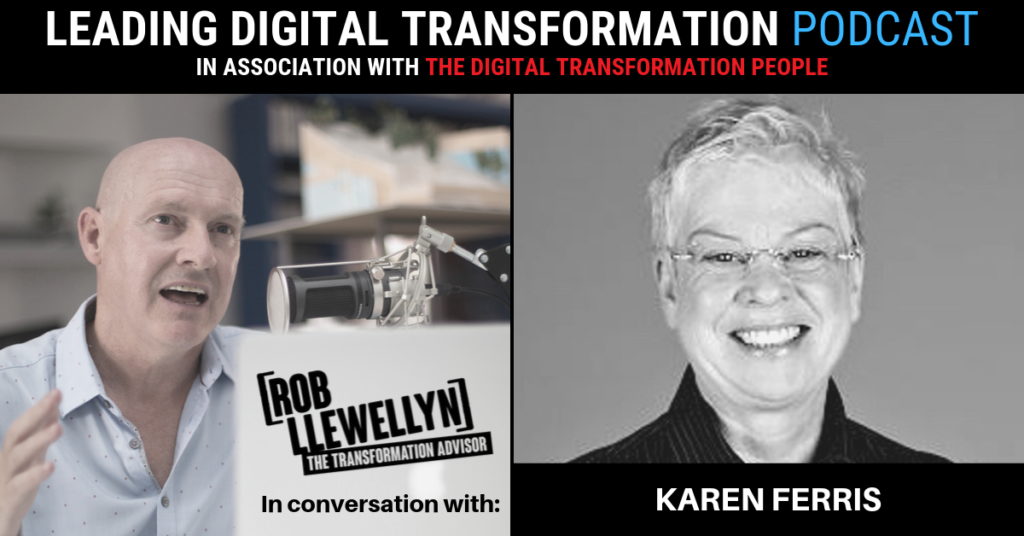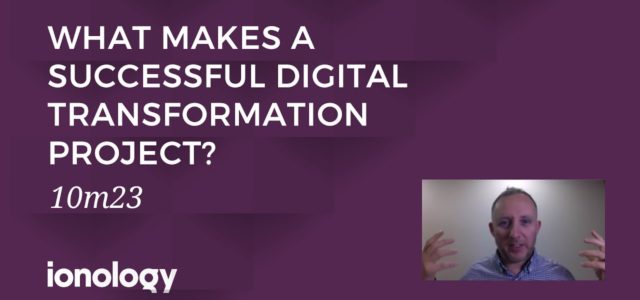Leading Digital Transformation’ is a weekly podcast series produced in collaboration between The Digital Transformation People and Rob Llewellyn digital transformation advisor and founder of CXO Transform.
During this series, Rob interviews experienced practitioners, authors and thought leaders whose stories and experiences provide valuable insights for digital transformation success.

In this episode, Rob speaks to Karen Ferris who describes herself as an organizational change management rebel with a cause who pushes the boundaries of the profession and challenges traditional ways of thinking. Obsessed with the people side of change in a world in which change is constant, volatile, uncertain and complex Karen is a firm believer that the key to organisational survival is resilience. As an author, speaker, educator and coach Karen shares her insights and experience to empower everyone to make a difference with their organization. Her two books Balanced Diversity (2011) and Game On! (2019) introduce an innovative framework for ensuring that organizational changes become embedded into the fabric of the organisation and go on to explore how every organisation can be fit, skilled, capable, supported and well-prepared for constant change. Born in Liverpool, UK, she immigrated to Australia in 1998. She is an avid Liverpool Football Club supporter, an Elvis fan, has an obsession for shoes, and is a self-confessed arctophile—you might want to Google that!
Meanwhile, Karen’s third book ‘Unleash The Resiliator Within’ is a work in progress.
“If you think of a soccer team, for example, every week, every game they play is different. The pitch, the supporters, the weather, the opposition, the tactics, the composition of the team and even during a game, there can be red cards and reduction in numbers, people change positions, the opposition changes the tactics and they don’t resist those changes. They say ‘game on’. And they’re resilient in the face of that constant change. They just embrace it. And that’s the workforce we need today. “
Listen here and read the full transcript below.
Transcript
Rob Llewellyn [00:00:21] There’s never been a need for organizational change management and a focus on the people side of change more than today. And while most leaders won’t disagree with that, a lot of organizations still struggle with it. My guest today is Karen Ferris who’s the author of several books about organizational change management. One is called “Balanced Diversity” and her most recent publication is called “Game on – Change is constant”. Karen helps organizations thrive in the face of volatile uncertain complex and ambiguous change (VUCA), providing new tools and approaches for a new age in organizational change management. Effectively, she’s trying to break the mould. Let’s jump into the interview with Karen. Karen, welcome.
Karen Ferris [00:01:09] Thank you, Rob. Great to be here.
Rob Llewellyn [00:01:12] Karen, you’ve published a book back a number of years ago called “Balance Diversity”. I know you’ve got another book coming out called “Game On”. Tell us why you’ve written those books in the course of your organizational change management career.
Karen Ferris [00:01:30] Good question, Rob, so the “Balance Diversity” book, when I wrote that, my background was primarily I.T. service management, but always with a focus on the people side of change. And I stumbled across the framework and of course I.T. love frameworks for embedding change into an organization and really presented 59 different activities that you could use to embed change. And that was really welcomed by the I.T. audience that it was intended for, because I.T. tended to use formal activities to embed change, like “we’ve done an audit” or “we’ve done some maturity assessments” and that was really the downfall from an I.T. perspective, we’d need more informal activities. And then “Game On – Change is Constant” was published earlier this year and the subtitle about tactics to win when change is everybody’s business. How leading change is everybody’s business. And that really is “how do organizations manage, I hate the word “manage”, deal with the people side of change when change is now constant?” You know, it’s happening all the time. It’s more disruptive. So what do we need to do to successfully transition through all of that change when it’s happening? And the third book is sitting on my desk as we speak which is called (it’s a bit quirky!): “Unleash the Resiliator Within” and the Resiliator is a superhero if you like with twenty superpowers that anyone can pull on at any time to be resilient in the face of constant change. The driver for that one I think we need to do a lot more to enable our workforces to be resilient when change is as uncertain and ambiguous as it is today.
Rob Llewellyn [00:03:20] Karen, tell us, why is organizational change management needed today more than ever before, due to digital transformation?
Karen Ferris [00:03:26] Yeah. So “organizational change management”, just so everyone is on the same page, because lots of people think you’re reorganizing the organization. And it was probably the worst title that the industry could-, or the profession could have given itself. So it’s all about helping with the people side of change, because whatever we do impacts people. And when we’re talking about digital transformation, the statistics are out there. The organizations are really struggling with it. And one of the reasons that is is that we tend to focus on the technology side of things. And McKinsey last year did some research and they found from the just under 1800 business executives that they spoke to, only 14 per cent of them said that they’ve got any sustained performance improvement from their digital transformation effort. And that’s crazy. And only 3 per cent of those 1800 said that the transformation was a complete success. So there was something seriously going wrong. And what I’m seeing is that we’re not looking at the people side of change as we should. And if you think about using the word transformation, I think we’ve been transforming forever and I think it’s probably the wrong word. I think digital disruption is more appropriate, and it is disruptive and it’s affecting, when we do it it’s going to require technology change, infrastructure change, process roles and all of those impact people. And it’s a massive change. So we need to make sure that everybody is part of that program of change or the continual improvement. And we also need a good cultural foundation, because digital disruption or transformation is going to require new ways of working, new ways of thinking, the fundamental mindset shifts and we need to have the foundation in place before we embark on that journey. And just one other thing to add, we’re all guilty of the new shiny thing and grabbing it and running with it. And I think organizations really need to ask the question and OCM should be driving this: “why are we doing it? Why do we need to transform digitally? Why do we need to be more agile? Why do we need to do whatever it might be before we jump on the bandwagon?” So we should be having a really good business case and it probably is there, but organizations aren’t asking that fundamental question, because if we don’t have that answer to that question, then what is the message you’re sending people in the organization about why we’re embarking on this very disruptive journey.
Rob Llewellyn [00:06:03] So Karen, why do you think that organizations don’t give OCM – and just for the audience, OCM is short for Organizational Change Management, less of a mouthful – why do you think organizations don’t give OCM the focus that it really deserves?
Karen Ferris [00:06:21] I think – and this probably is a generalization – that people always seem to be the afterthought in many organizations. For years we’ve seen projects remove training, remove organizational change management activities as they’re running up to a deadline. It’s the first thing that gets dropped and I don’t think organizations actually yet see the return on investment. And I think that’s partly because the profession itself has struggled to put measurable outcomes on organizational change management activities. And the organizational change management profession is still a relatively young one and I’m not quite sure it’s really found its place and its feet. So, organizations talk about organizational change Management, OCM, and I’ll go into an organization [of] say 4000 employees and you look-, “OK, where’s your organizational change management capability? Oh it’s that person sitting over there.” Well, there’s your problem, because they can’t do when we’re doing as much change as we’re doing today that one person can’t be doing everything for every initiative of every project. So I don’t think the organizations are looking at that people side of change the way that they should be. And there needs to be, because when change is getting as constant as it is, you know we’re all hearing about anxiety and stress in the workplace and fatigue and burnout and all that sort of stuff. So the time really is now for organizations to stop just giving lip service and actually do something.
Rob Llewellyn [00:08:05] Karen, I’ve got a big smile on my face here, because what you just said is really the question I was going to ask, because we both go in and out of organizations, as do a lot of people listening to this podcast. And I have to say that I’ve not been into an organization over the last 20 years where somebody has not mentioned Organizational Change Management, but it comes down to as you just eluded to having you know 5, 10, 20, 30, 40,000 people in an organization and they point to that single person: “oh, they take care of OCM”, as you say, organizations are often paying lip service to OCM. They’re acknowledging the fact, “Yes, we need to do that.” It’s the right thing, but they’re not investing in it.
Karen Ferris [00:08:49] Correct. Absolutely. They are hiring a couple of people maybe who’ve got organizational change management capability and then they think “that’s it” because they can tick the box. “Yes, we’ve done something.” But I think there’s also not an understanding of what OCM really is. And, you know, we will talk about this bit later I guess as well but you know it’s just about communication. So that’s all we need. We need two or three people, they can do all the communications we need. Well OCM is a lot more than just comms.
Rob Llewellyn [00:09:22] Karen, how does OCM have to fundamentally change then, when change is constant as most people know these days and it’s quite uncertain in the digital world that we’re living in because things are just changing so fast. So, what has to fundamentally change with OCM?
Karen Ferris [00:09:38] So, for me, this is where I’ve been pushing a few buttons across the industry over the last couple of years. The organizational change management approaches, methodologies, frameworks, whatever you want to call them, the majority of them, if not all of them, have been based on a 1940s alluded statement – and I’ll expand on that in a moment – from American-German psychologist Kurt Lewin, who said “change could be done in three steps”. You unfreeze the current situation, you make the change and then you refreeze so there’s some stability. And I won’t name them but all the frameworks basically are based on that. I mean even William Bridges said, “letting go and transitioning and new beginnings, it’s all one, two, three stop”. Well, change isn’t like that anymore, it’s not linear. Change is cyclic and it’s rapid and it’s fast and the days of organizational change management professionals saying “Well, okay I’ll write up my change strategy and I’ll write my change communication plan and my training plan and my reinforcement plan and my sponsorship roadmap and my stakeholder engagement. And now I’ve done all those things. I’m ready to go.” Well, I’m sorry guys, the project’s left the building, the world’s moved on. But those are the things, those documents and artefacts are what people have been equipped with generally through the training and the certifications they’ve done in organizational change. So there’s a few people now saying “Okay, well how do we – and some people are calling it agile change or you know people are talking about the science of change management and really shifting the industry, but yes, it really has got to move away from that concept of it being the role of a couple of people, to one where change is everybody’s business. It has to be, and organizational change management really needs to strategize about how we create a resilient workforce.
Rob Llewellyn [00:11:42] So, Karen, we’ve talked a couple of times now about the fact that organizations are not investing sufficiently in OCM capabilities and that’s probably not going to change overnight. So, in light of that challenge, how can OCM deal with the amount of change happening when there are generally only a few OCM practitioners in these organizations, some of which are really large – tens of thousands of people in some instances.
Karen Ferris [00:12:13] Absolutely. So, Rob, I use the analogy of a soccer team, you know I’m from Liverpool so I have to. I talk about – you could use any sporting analogy to explain the capability that I think organizations need to develop and being driven by OCM. If you think of a soccer team, for example, every week every game they play is different. The pitch, the supporters, the weather, the opposition, the tactics, the composition of the team and even during a game, there can be red cards and reduction in numbers, people change positions, the opposition changes the tactics and they don’t resist those changes. They say ‘game on’. Hence, the name of my latest book. And they’re resilient in the face of that constant change. They just embrace it. And that’s the workforce we need today. We really have to have – the change is constant, bring it on. So, we have the players, what OCM need to do is become the managers, like a soccer team manager. You don’t have to call them these titles. It’s just the analogy. But the managers get off the pitch and they set strategy, working with the players and the coaches, but they set strategy: how are we going to build a resilient workforce, what’s working what’s not? Do we need to change our direction? Do we need to change our approach? And the third aspect in that coalition are the coaches. So these are what traditionally organizations have called the change agent, the change advocates or the change champions distributed throughout the organization. What’s traditionally happened as well is these people have put their hands up to be a change champion, they’ve been given a lanyard that says “change champion” and that’s about it. They haven’t been equipped to do organizational change management at all. So, OCM in that management, strategic management role, needs to educate and give people the capability and create a competent Change Network at every level of the organization, throughout the organization, that can make sure that the players have the right training, the right equipment, the right resources to win the game that organization is playing. So that OCM stepping back and looking at the big picture, because at the moment most of OCM professionals are doing the doing and get this competent network to drive change throughout the organization. That’s the only way we’re going to deal with the amount of change that’s happening and the coaches’ feedback, they get feedback from the players, they feedback to the managers, you know what’s working, what’s not working, what do we need to do differently. And until we make change everyone’s business, as I mentioned before, organizations just aren’t going to cope with the rate of change that’s happening. And I’ve talked to OCM professionals and they go “oh well, there’s two or three of us and we just got allocated to what people think are the highest priority projects or programs.” So, all the others are just going ahead without any organizational change. So organizations are not going to suddenly invest in you a team of 50 organizational change professionals to be the managers. So they need to equip the rest of the organization and change agents.
Rob Llewellyn [00:15:31] Karen, why do you think that companies, many companies, not all, but many companies, are not taking OCM seriously enough? I mean, the reports are out there from all the big consulting firms, the academic researchers out there, most of the large organizations that are helping companies implement change and transformation talk about OCM and even we’re hearing CEOs talk these days more about people. Why is it, do you think, that despite all of this, there’s still not enough investment in OCM?
Karen Ferris [00:16:09] Yeah, I think it’s a good question and I’m not sure I have the definitive answer. I talk to a lot of potential clients and they go “yes, yes” the nodding and then it’s like “hmm but maybe not just now”. And I think they’re not feeling the pain yet. And you as you say, there’s lots of reported statistics that say if you don’t do it, this is what will happen to you. And there’s some shining examples like if you don’t get people to innovate you’ll go down the roads of Kodak and Blockbuster and we’ve just had – what’s the holiday company that’s just gone under – [Thomas Cook]. And you know rest resting on their laurels because of their existing success. So yeah, they’re not feeling the pain themselves and some of the statistics are out generally globally. Employee turnover is at the lowest it’s ever been. Generally globally, the lowest. So organizations are probably going “Woo, that’s really good! Low turnover.” The other statistic alongside that is that employee engagement is at the lowest it’s ever been, globally. So that means people aren’t leaving the organization but they’re also totally disengaged. So that’s complacency, where people are just turning up for a paycheque. Now what that means to those organizations is they will fail to innovate. They’ll fail to respond to competition. They’ll fail to respond to consumer and customer demand and they will start to die a slow and painful death, because someone else is going to do it faster than them, sooner than them, better than them. And I feel that until they feel that happening and it’s happening more and more, that maybe organizations are not just sitting up and taking note, they’re sort of getting away with it. They’re surviving but I don’t think they’re going to thrive. And until we have more of those stories that say if we’d done OCM we wouldn’t be in the situation we are, then maybe people would sit up and listen.
Rob Llewellyn [00:18:08] I don’t want to jump in there, Karen, and I know it was on the tip of your tongue but you couldn’t quite get it out. It was Thomas Cook.
Karen Ferris [00:18:13] Thomas Cook, yeah.
Rob Llewellyn [00:18:14] Exactly. I didn’t want to jump in because we’ve got a big-time lag. For those of you listening, I’m in Spain and Karen is in Australia, so we’ve got a bit of a time lag going on that we need to deal with. But yeah, really sad to see an organization that was – Mr. Thomas Cook founded that in 1841 and its gone bankrupt this week, so sad. Anyway, let’s move on. What are some of the myths, Karen, about OCM? I mean everybody mutters the words OCM, but they don’t necessarily know the right things. Tell us some of the myths that are being bandied around organizations.
Karen Ferris [00:18:48] Yeah. So what I mentioned earlier, that people seem to think that OCM is about communications, just comms and we hear people say “Oh, we sent out an email telling them this change was coming. So why don’t they get it?” Well, that is not communication, that’s broadcasting to start with. And OCM is a lot more than just sending communications out. Communications is a big part of it, but it’s also about what’s the right comms, what’s the right channel, what’s the right frequency? Who is the audience, what’s the context, what is it they want to know? and it’s more having an open dialogue conversation and it’s a two-way conversation. So it’s not just about comms, it’s about engagement, it’s about stakeholder position, it’s about where people are in terms of the feeling about the change. We’ve talked about “it’s just the job of a few people”. It can’t be, as we’ve explored. The myth that people resist change. I say all the time “people don’t resist change when it’s done WITH them. They resist change when it’s done TO them, which often happens. They don’t know why the change is happening, they don’t know what impact is going to have on them. So, of course, they’ll resist it, if they haven’t been engaged and had the conversation. So people don’t generally resist change. And also the myth that resistance to change is a bad thing. Well, not really because as an OCM professional, if people are resisting change, I either haven’t communicated effectively, so it’s informing me that I need to up my game, so that’s a good thing, so it forms your strategy. And if a large amount of people are resisting change, it might be that your change is a bad idea. They might actually have something to say – we don’t believe this is the right way to go. So yeah, it’s not always a bad thing. And the other one, people think there’s no return on investment, which I think is why one of the reasons they don’t give it the focus it should have. And again, the evidence is out there. If you have OCM, you will have longer-term adoption of your change, it’ll contain costs – from rework in terms of getting people on board, getting people to use new processes, getting people to use new tools. It reduces the time to implement a change. I often say “projects install change, OCM implements them and makes them happen” and it ensures that everyone’s on the journey, so you’re going gonna get a smooth transition to a new way of working or whatever it might be without disrupting business as usual, which can be dangerous.
Rob Llewellyn [00:21:23] Karen, in your latest book, you talk about “killing a hierarchy”. What do you mean by that?
Karen Ferris [00:21:29] Yes. So I think hierarchy and especially bad bureaucracy, we just have to get rid of it when change is constant, complex, ambiguous and it’s just getting faster and faster and it’s getting more and more disruptive because we can’t foresee often where the change is coming from. So we need to make change everyone’s business. But if we have a hierarchy with the traditional sort of command and control approach, then the organization is going to be too slow. If a decision has to go up a chain of command before an answer can come back down. The opportunity that was facing us or the challenge or the issue we were dealing with that’s gone is either blown up in our face or an opportunity has been missed. So we’ve got to decentralize decision making. I often see people go “[sharp intake of breath], if we give everybody the power to make decisions and drive change it’ll be chaos!” Well, it isn’t, because alongside the autonomy we give them, we give them guardrails within which to operate and they are basically principles to say these are the things you can do – and this is a very simple example – but tick these boxes, I will do right by the customer, I’ll do right by the company and I’ll do right by my colleagues. And if I tick those boxes, I am doing something with the right intent and therefore I have permission to do it. If I think I’m going to adversely impact one of those three parties, then I shouldn’t do it. As simple as. So yeah, we need to give people autonomy. We need to start treating our workforce as adults and give them the autonomy to get on and do the job. So we need to get rid of that bureaucracy of hierarchy, where it’s only people with a certain title that can actually initiate and drive change.
Rob Llewellyn [00:23:24] Karen, I could continue speaking and hearing from you on this, because I’m really passionate about the subject but I’m afraid we’re gonna have to wrap it up. But before we go, tell us where can people go to learn more about what you’ve got to share on the subject of OCM?
Karen Ferris [00:23:42] Absolutely. Just head over to my website which is KarenFerris.com. I’m active on LinkedIn, seek me out there. And if you’re interested in “Game on – Change is constant”, then the book is available as a hardcopy, also as an e-book on Amazon.
Rob Llewellyn [00:24:03] Perfect and we’ll put links to those in the show notes. Karen, thank you so much for joining me today. It’s been a real pleasure speaking with you.
Karen Ferris [00:24:11] Thank you, Rob, enjoyed it.
Announcer [00:24:13] We hope you enjoyed this episode of “Leading Digital Transformation” with Rob Llewellyn and The Digital Transformation People. Visit www.thedigitaltransformationpeople.com to secure the knowledge, talent and services you need for digital transformation success. To continue your journey as a certified transformation professional, visit www.RobLlewellyn.com. Be sure to subscribe to the podcast and follow us on Twitter @TheDigitalTP and @RobertLlewellyn
Article by channel:
Everything you need to know about Digital Transformation
The best articles, news and events direct to your inbox
Read more articles tagged: Change & Transformation, Featured, Leadership






